AQA AS ECONOMICS: Unit 1 Markets and Market Failure SECTION A
Q.1. A free good
- A. is paid for by the government.
- B. has zero opportunity cost in its supply.
- C. has a negative social cost.
- D. has a perfectly inelastic supply
Answer: B- has zero opportunity cost in its supply
Q.2. The equilibrium market price can be defined as the price at which
- A. the market for the product clears.
- B. the price elasticity of demand equals the elasticity of supply.
- C. producers maximise their profits.
- D. positive excess demand equals negative supply.
Answer: A- the market for the product clears.
Q.3. The diagram below illustrates the industry supply curve for mobile phones.
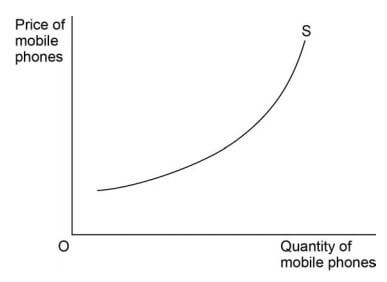
All other things being equal, the upward slope of the supply curve is due to
- A. the existence of a monopoly in the industry.
- B. higher prices providing a profit incentive for firms to expand production.
- C. the elasticity of supply exceeding the elasticity of demand for mobile phones.
- D. higher prices providing an incentive for firms to increase their productive efficiency.
Answer: B- higher prices providing a profit incentive for firms to expand production.
Q.4. The free market equilibrium price for a merit good is £50 per unit. At present, the government does not intervene in the market for this good. The government is most likely to correct the market failure associated with this merit good if it
- A. imposes a maximum price of above £50 per unit.
- B. sets a minimum price of £50 per unit.
- C. taxes the free market price.
- D. subsidies the free market price
Answer: D- subsidizes the free market price.
Q.5. The four diagrams below relate to the provision of medical services at a local hospital. The services are currently provided free. It has been suggested that patients could pay £20 each time they receive treatment at the hospital to reduce pressure on its fixed capacity and to reduce waiting times for treatment.
Which one of the diagrams, A, B, C or D, best illustrates the effects of such a policy?
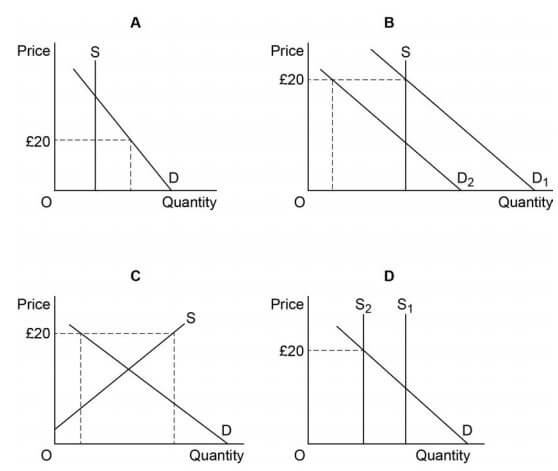
Answer:
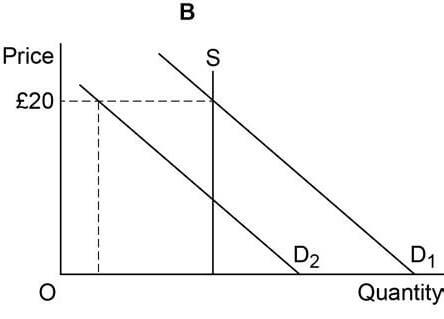
The supply of medical services is provided for free now (S), thus the demand for them is high (D1). The hospital now has decided to reduce the pressure on the fixed capacity its staff and also the waiting time for treatment, thus, they suggested that patients could pay £20 each time they receive treatment at the hospital. Due to this decision, now the cost of receiving medical services will go up, thus the demand will come down to D2, supply being constant.
Q.6. The table below shows the private and external costs for four products. Which product, A, B, C or D, has a market price which takes least account of negative externalities?
| Product | private cost per unit of output £ | External cost per unit of output £ | Market price £ |
|---|---|---|---|
| A | 10 | 2 | 12 |
| B | 12 | 5 | 15 |
| C | 16 | 7 | 22 |
| D | 22 | 8 | 24 |
Answer: D: product D has market price which takes least account of negative externalities because the external cost per unit of output is highest in case of product D i.e. £8 per unit of output. Also, the share of external cost per unit of output from the total market price is highest.
Q.7. Which one of the following provides a reason why governments should intervene in a market economy?
- A. Small firms are less efficient than large firm’s due to economies of scale.
- B. The existence of free riders will result in the overproduction of public goods.
- C. The social benefits of some private goods exceed the private benefits.
- D. Private firms are unable to produce merit goods in a free market.
Answer: D- Private firms are unable to produce merit goods in a free market.
Q.8. The diagram below illustrates the market demand (D) and market supply (S) curves for a good. The production of the good creates a negative externality.
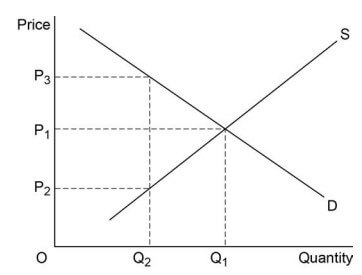
To reduce production and consumption of the good to OQ2, the government could impose a
- A. price ceiling of OP3.
- B. tax of P2P3.
- C. minimum price of OP2.
- D. tax of P2P1.
Answer: B- tax of P2P3.
Q.9. The table below shows possible sources of market failure in current UK markets.
Which combination of example and policy, A, B, C or D, is consistent with the possible source of market failure identified?
| Source of market failure | Example of market failure | Policy to correct market failure | |
|---|---|---|---|
| A | Public good | Healthcare | State provision |
| B | Positive consumption externalities | Education | Minimum price |
| C | Merit good | Petrol | Indirect taxation |
| D | Negative production externalities | Electricity generation | Pollution permits |
Answer: D- Negative production externalities arise from electricity generation like pollution etc. which leads to market failure. Thus, policy provision like pollution permits would help in correcting the market failure.
Q.10. All other things being equal, when the equilibrium price of car tyres in a market rises from £60 to £90, the quantity demanded falls from 2 million units to 1.5 million units. Therefore, the value of the price elasticity of demand is
- A. +2.5
- B. +0.5
- C. –0.5
- D. –2.0
Answer: C: -0.5
Price elasticity of demand is percentage change in quantity demanded by percentage change in price.
% change in quantity demanded= -0.5million/ 2 million= -0.25 × 100 = - 25%
% change in price = 30/60 = 0.5 × 100= 50%
Thus price elasticity of demand = -25%/ 50% = -0.5
Q.11. The existence of scarcity in an economy implies that
- A. there are no free goods.
- B. there are no public goods.
- C. individuals must make choices.
- D. there has been a misallocation of resources.
Answer: A- there is no free goods
Q.12. The diagram below shows the production possibility boundaries for Countries X and Y respectively.
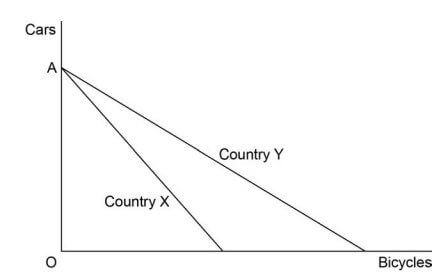
The opportunity cost of cars in terms of bicycles
- A. is greater for Country X than for Country Y.
- B. is greater for Country Y than for Country X.
- C. increases as more cars are produced.
- D. increases as more bicycles are produced.
Answer: B- is greater for Country Y than for Country X.
Q.13. The table below indicates the average price of furniture as a price index.
| Year | Price index |
|---|---|
| 2011 | 100 |
| 2012 | 105 |
| 2013 | 120 |
| 2014 | 110 |
| 2015 | 125 |
Which one of the following can be deduced from the data above?
- A. The price of furniture rose throughout the whole period 2011 to 2015.
- B. Compared with 2015, the price of furniture was 20% cheaper in 2011.
- C. Revenue from the sale of furniture fell in 2014.
- D. Between 2013 and 2014, the price of furniture fell by 10%.
Answer: B- Compared with 2015, the price of furniture was 20% cheaper in 2011.
% change in price compared with 2015: (125-100)/ 125 = 25/125 ×100 = 20%
Q.14.Which one of the following is the most likely disadvantage that may arise from the growth in the size of a firm?
- A. Increased division of labour reduces productivity
- B. An increase in the size of the marketing budget
- C. The need to purchase components in large quantities
- D. Problems in coordinating different parts of the business
Answer: D- Problems in coordinating different parts of the business
Q.15. The diagram below shows the marginal private and social benefit (MPB and MSB) curves and the marginal private and social cost (MPC and MSC) curves for a good which generates negative externalities in production.
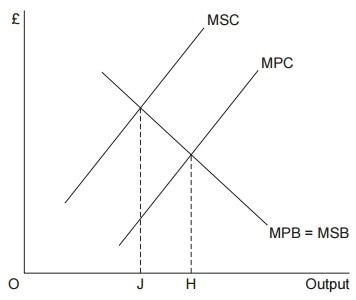
In the absence of government intervention, a misallocation of resources is likely to occur because
- A. there is underconsumption of JH.
- B. market output is too low.
- C. market price is too high.
- D. there is overproduction of JH.
Answer: D- there is overproduction of JH.
Q.16. A firm is productively efficient when
- A. it is operating at the lowest point on its average cost curve.
- B. it cannot increase current production even if the demand for its products increases.
- C. output per worker cannot increase.
- D. an increase in production will decrease average costs.
Answer: A- it is operating at the lowest point on its average cost curve.
Q.17. The use of money as a medium of exchange enables an economy to
- A. operate outside its production possibility boundary.
- B. increase the production of public goods.
- C. prevent market failure.
- D. benefit from specialisation and the division of labour.
Answer: C- prevents market failure.
Q.18. The two diagrams below show the markets for Goods X and Y.
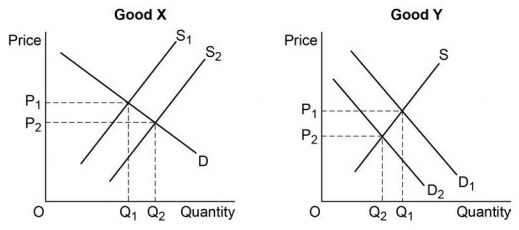
The markets are initially in equilibrium at P1 and Q1. If the supply of Good X increases and both markets move to a new equilibrium at P2 and Q2, it may be concluded that Goods X and Y are in
- A. competitive demand.
- B. derived demand.
- C. composite demand.
- D. joint demand.
Answer: A- Competitive demand.
Competitive demand is the demand for products that are competing for sales i.e. people can substitute one good for another. Here, demand for Good X increases thus, the demand for its substitute/competitor Good Y decreases.
Q.19. Which one of the following combinations, A, B, C or D, is most likely to increase a firm’s monopoly power?
| Barriers to entry | Product differentiation | |
|---|---|---|
| A | Increase | Decrease |
| B | Increase | Increase |
| C | Decrease | Increase |
| D | Decrease | Decrease |
Answer: A- Barriers to entry increase and product differentiation decrease.
Q.20. An indirect tax on the production of a good will have no effect on its market price if demand is
- A. inversely related to price.
- B. unit elastic.
- C. perfectly elastic.
- D. perfectly inelastic.
Answer: D- perfectly inelastic
Q.21.Complete market failure exists when
- A. there are negative externalities in production.
- B. the free market fails to provide sufficient merit goods.
- C. the free market underprices demerit goods.
- D. there is a missing market in the provision of public goods.
Answer: D- there is a missing market in the provision of public goods.
Q.22. The cross price elasticity of demand for two products which are close substitutes for each other will be
- A. high and positive.
- B. low and positive.
- C. low and negative.
- D. high and negative.
Answer: A- high and positive.
Cross-price elasticity value is positive when the two goods are substitutes i.e. as the price of one good increase, the demand for the other good increases. Also, in case of close substitutes, the coefficient of cross price elasticity is high.
Q.23. The size of a firm increases. As a result, its long run average costs fall because the firm utilizes its factory more efficiently and the advertising cost per item decreases. Therefore, the firm experiences
- A. technical and marketing economies of scale.
- B. purchasing and marketing economies of scale.
- C. financial and purchasing economies of scale.
- D. financial and technical economies of scale.
Answer: A- technical and marketing economies of scale.
Q.24. If the consumption of a product results in a negative externality, it follows that
- A. an optimum allocation of resources can never be achieved.
- B. non-consumers benefit at the expense of consumers.
- C. an optimum allocation of resources can be achieved by placing a tax on the product.
- D. social benefits of consumption exceed social costs.
Answer: C- an optimum allocation of resources can be achieved by placing a tax on the product
Q.25. Which one of the following is most likely to be a reason for government failure?
- A. The negative externalities that result from the production of some goods and services
- B. The difficulties in determining the true social costs and benefits of merit goods
- C. Missing markets for public goods and merit goods
- D. Excessive consumption of demerit goods
Answer: C- Missing markets for public goods and merit goods
AQA AS Economics Questions With Answers
- AQA AS Economics Unit 1 Section A
- AQA AS Economics Unit 1 Section B Part 1
- AQA AS Economics Unit 1 Section B Part 2
- AQA AS Economics Unit 2 Section A
- AQA AS Economics Unit 2 Section B part 1
- AQA AS Economics Unit 2 Section B part 2
- AQA AS Economics 2015 Unit 1 Section A
- AQA AS Economics 2015 Unit 1 Section B Part 1
- AQA AS Economics 2015 Unit 1 Section B Part 2
- AQA AS Economics 2015 GCSE solved Question Paper


